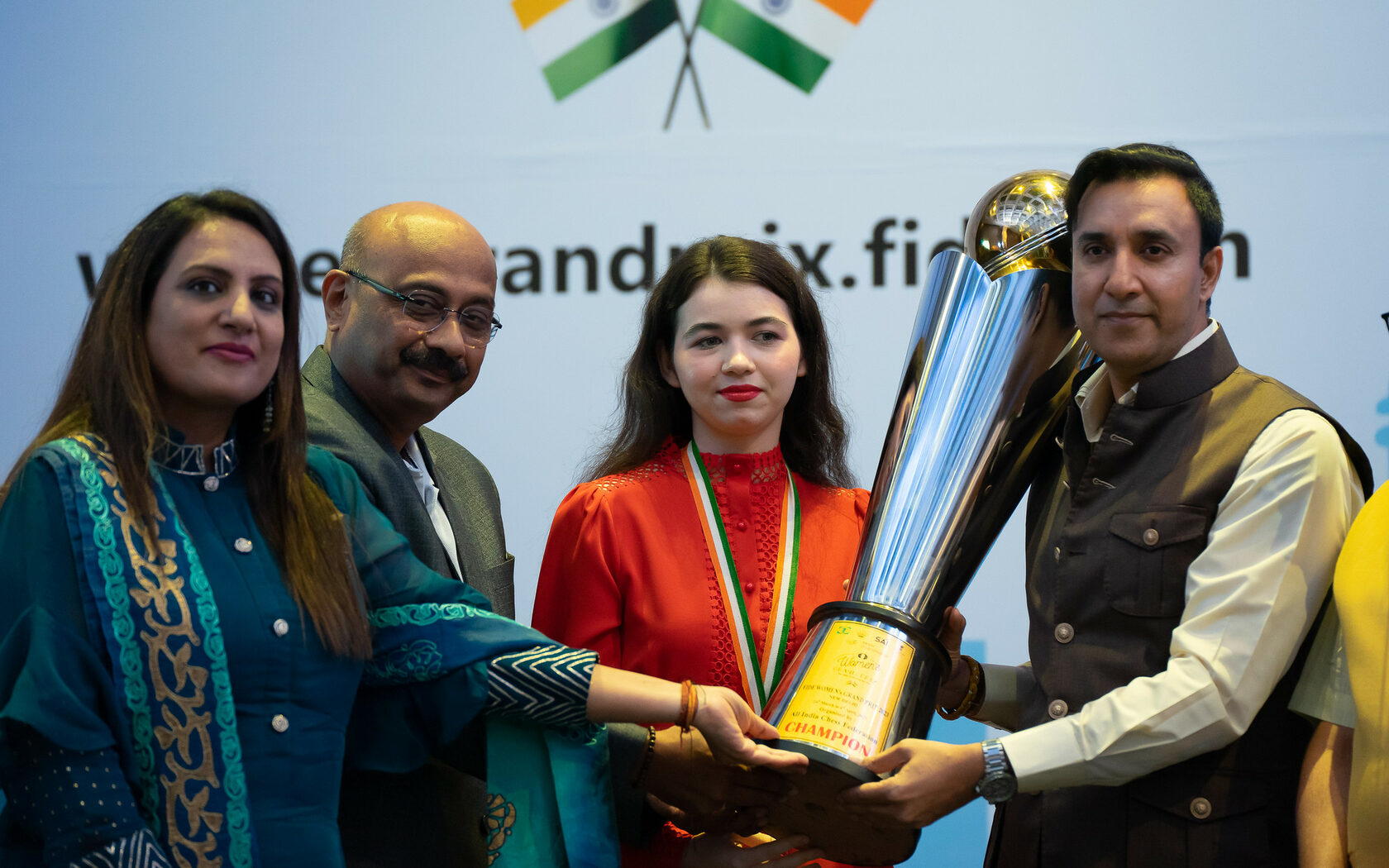The top three contenders for first place in the third leg of the Women’s Grand Prix all drew their final round games, finishing on six points. After tiebreaks, Aleksandra Goryachkina was awarded first place, Bibisara Assaubayeva is second and Zhu Jiner third
The final, eleventh round of the third leg of the Women’s Grand Prix cycle ended with all three tournament leaders drawing their games and finishing on six points. Aleksandra Goryachkina was awarded first place for having better tiebreaks.
As per tournament regulations, all prize money and WGP points were divided equally among the players with an equal final score. This means that Goryahckina, Assaubayeva and Zhu all got 12,333 euros and 133 points each.
How the final round unfolded
The first one to finish, after around two hours and 45 minutes of play, was China’s Zhu Jiner. Playing as Black against Nino Batsiashvili, the position was even and after forced exchanges of heavy pieces, the two agreed to split a point. With this draw, Zhu reached her third GM norm (having collected the first two in the previous two tournaments of the Women’s Grand Prix – in Astana and Munich). China and the world now have a new Grandmaster – Zhu Jiner.
The final, eleventh round of the third leg of the Women’s Grand Prix cycle ended with all three tournament leaders drawing their games and finishing on six points. Aleksandra Goryachkina was awarded first place for having better tiebreaks.
As per tournament regulations, all prize money and WGP points were divided equally among the players with an equal final score. This means that Goryahckina, Assaubayeva and Zhu all got 12,333 euros and 133 points each.
How the final round unfolded
The first one to finish, after around two hours and 45 minutes of play, was China’s Zhu Jiner. Playing as Black against Nino Batsiashvili, the position was even and after forced exchanges of heavy pieces, the two agreed to split a point. With this draw, Zhu reached her third GM norm (having collected the first two in the previous two tournaments of the Women’s Grand Prix – in Astana and Munich). China and the world now have a new Grandmaster – Zhu Jiner.
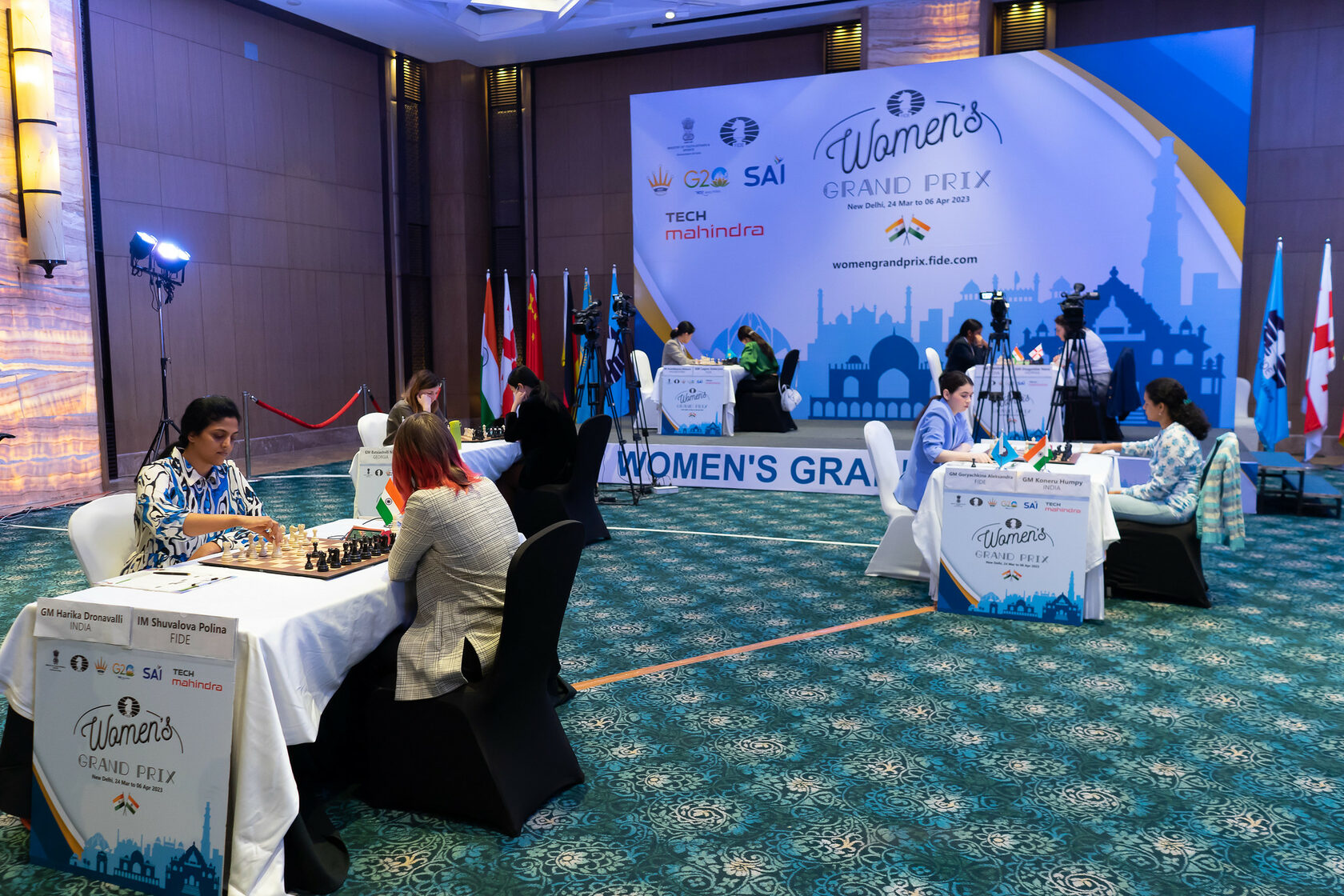
Just a few minutes after Zhu, Aleksandra Goryachkina – the other of the three favourites – drew as White with India’s top player and world number two, Humpy Koneru. In the Queen’s gambit accepted, both sides played precisely. It was a balanced game, ending in an even position.
Some 15 minutes later, Bibisara Assaubayeva (one of the three leaders) agreed to split a point with Kateryna Lagno. In the Reverse Benoni, Assaubayeva had slightly more initiative, but it was overall even. With this tournament in New Delhi, Bibisara Assaubayeva also achieved her second Grandmaster norm.
After more than five hours of play, Polina Shuvalova beat Harika Dronavalli in the Ruy Lopez, while Vaishali Rameshbabu lost a drawn-rook endgame to Nana Dzagnidze.
The final standings of the third leg of the Women’s Grand Prix in New Delhi:
Some 15 minutes later, Bibisara Assaubayeva (one of the three leaders) agreed to split a point with Kateryna Lagno. In the Reverse Benoni, Assaubayeva had slightly more initiative, but it was overall even. With this tournament in New Delhi, Bibisara Assaubayeva also achieved her second Grandmaster norm.
After more than five hours of play, Polina Shuvalova beat Harika Dronavalli in the Ruy Lopez, while Vaishali Rameshbabu lost a drawn-rook endgame to Nana Dzagnidze.
The final standings of the third leg of the Women’s Grand Prix in New Delhi:
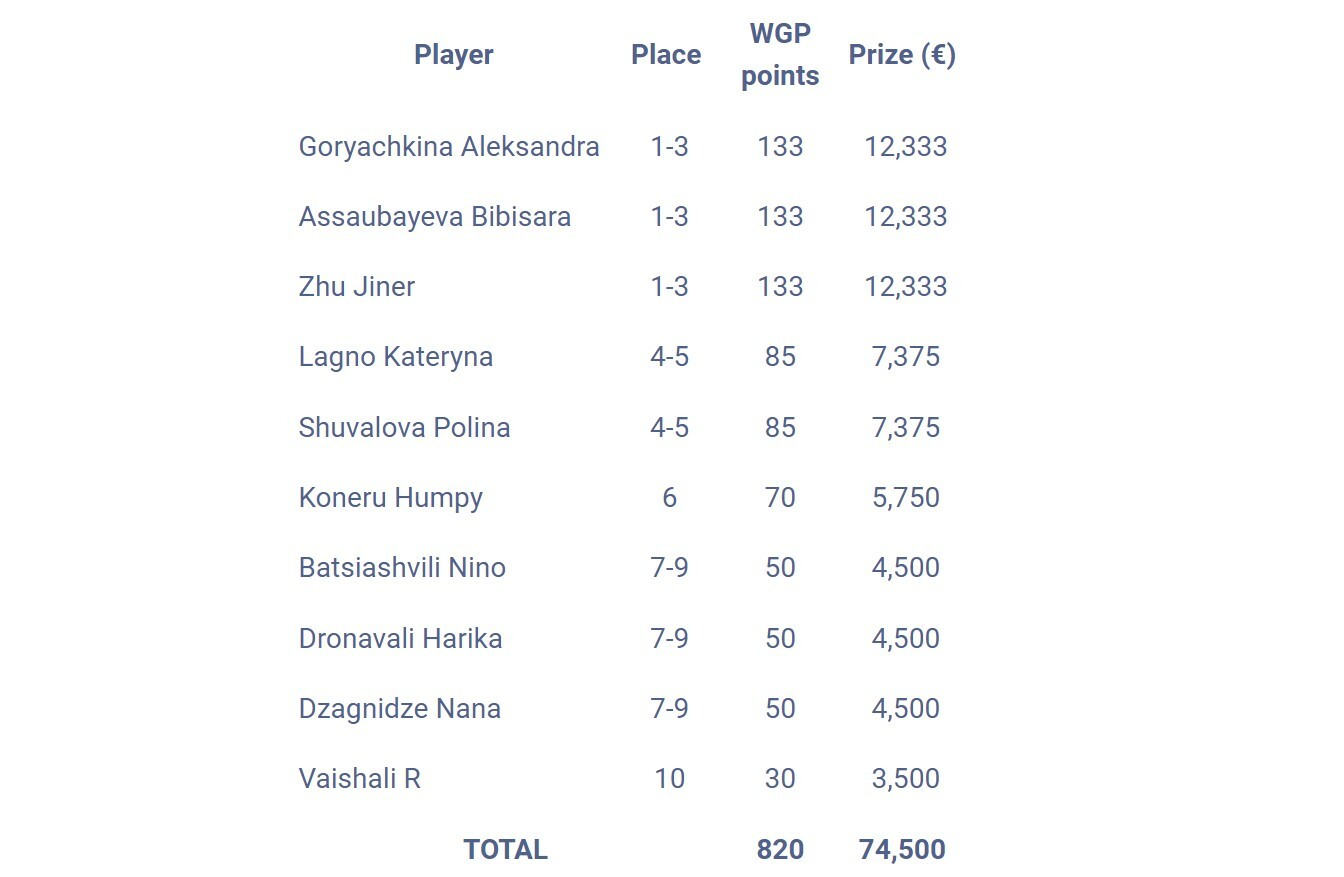
The overall standings in the Women’s Grand Prix 2022/2023 series
With a total of 308 points, China’s Zhu Jiner is currently in the lead in the overall standings of the Women’s Grand Prix. She is followed by Aleksandra Goryachkina, who is on 263 points, while Alexandra Koteniuk (who skipped New Delhi) is in third place on 250, closely followed by Kateryna Lagno, who is on 245 points.
Zhu’s lead is, however, only symbolic. New Delhi was her third and final appearance in this edition of the WGP cycle. (In the previous events, she secured a third-place finish in Astana, earning 110 points, and fetched another 65 points in Munich.) She will be overtaken after the next and final leg of the Women’s Grand Prix, where top favourites such as Goryachkina, Kosteniuk and Lagno will take part. Still, New Delhi will be a memorable tournament for Zhu as in this event she has also secured her third Grandmaster norm.
With this victory in New Delhi, Aleksandra Goryachkina now has 263 points and is currently in second place in the overall standings. Goryachkina came in second in the first tournament in Astana (where she collected 130 points), and first place in New Delhi got her additional 133 points. As this was her second tournament in this WGP cycle, Goryachkina is due to play in the fourth and final leg, which will take place in Cyprus in May. This makes her a very strong contender for the winner of the 2022/2023 edition of the Women’s Grand Prix.
The event in Delhi was also the second tournament in the WGP cycle for Bibisara Assaubayeva. Having collected just 30 points in Astana in the first tournament, second place in New Delhi and 133 points boosted her place in the overall standings, as well as her chances to reach one of the top places in this edition of the WGP.
With a total of 308 points, China’s Zhu Jiner is currently in the lead in the overall standings of the Women’s Grand Prix. She is followed by Aleksandra Goryachkina, who is on 263 points, while Alexandra Koteniuk (who skipped New Delhi) is in third place on 250, closely followed by Kateryna Lagno, who is on 245 points.
Zhu’s lead is, however, only symbolic. New Delhi was her third and final appearance in this edition of the WGP cycle. (In the previous events, she secured a third-place finish in Astana, earning 110 points, and fetched another 65 points in Munich.) She will be overtaken after the next and final leg of the Women’s Grand Prix, where top favourites such as Goryachkina, Kosteniuk and Lagno will take part. Still, New Delhi will be a memorable tournament for Zhu as in this event she has also secured her third Grandmaster norm.
With this victory in New Delhi, Aleksandra Goryachkina now has 263 points and is currently in second place in the overall standings. Goryachkina came in second in the first tournament in Astana (where she collected 130 points), and first place in New Delhi got her additional 133 points. As this was her second tournament in this WGP cycle, Goryachkina is due to play in the fourth and final leg, which will take place in Cyprus in May. This makes her a very strong contender for the winner of the 2022/2023 edition of the Women’s Grand Prix.
The event in Delhi was also the second tournament in the WGP cycle for Bibisara Assaubayeva. Having collected just 30 points in Astana in the first tournament, second place in New Delhi and 133 points boosted her place in the overall standings, as well as her chances to reach one of the top places in this edition of the WGP.
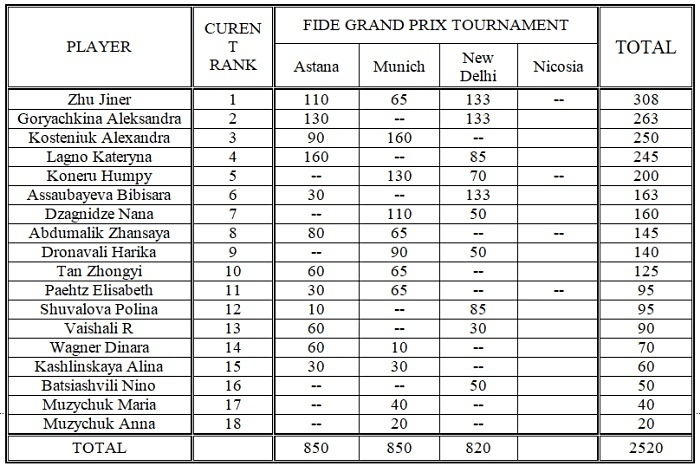
The tournament in New Delhi was the third in a series of four which make up the Women’s Grand Prix (WGP). Altogether 16 players are taking part in the series, with each participating in three of the four tournaments. The two players who score the greatest number of cumulative points in the series shall qualify for the FIDE Women Candidates Tournament 2023-24.
The next and final event in the Women’s Grand Prix cycle will be held in Cyprus between the 15th and 28th of May.
Round 11 Games Recap
Bibisara Assaubayeva – Kateryna Lagno
The next and final event in the Women’s Grand Prix cycle will be held in Cyprus between the 15th and 28th of May.
Round 11 Games Recap
Bibisara Assaubayeva – Kateryna Lagno
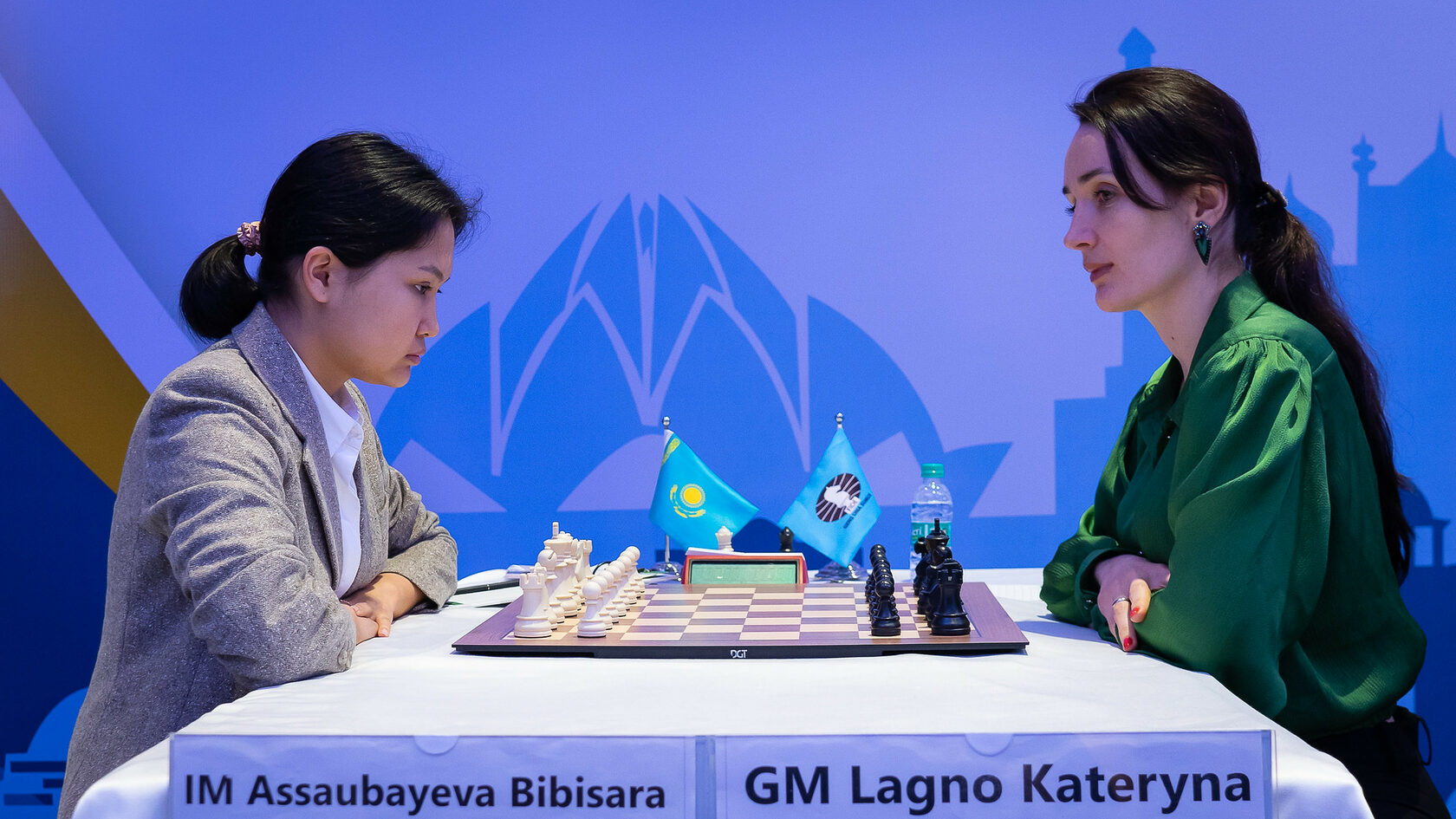
Kateryna Lagno is the more senior player of the two – both in experience and titles won but also in the overall score: the two have played 25 games – and Lagno leads 12:4.
Once again, in a game where Bibisara was playing with white pieces, we saw the Reverse Benoni. Both sides fought for control of the dark squares in the centre. On move 11 Lagno deviated from the book theory and introduced a novelty 11…Rb8 and reached equality.
Once again, in a game where Bibisara was playing with white pieces, we saw the Reverse Benoni. Both sides fought for control of the dark squares in the centre. On move 11 Lagno deviated from the book theory and introduced a novelty 11…Rb8 and reached equality.
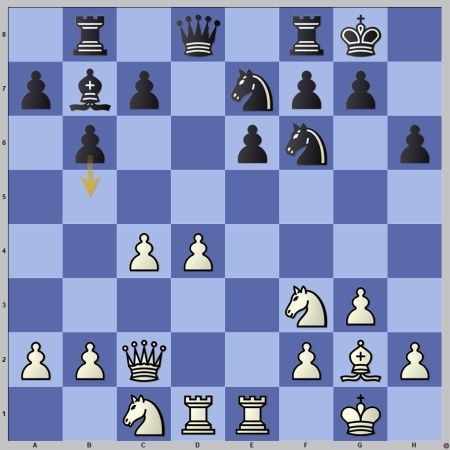
However, instead of slow manoeuvring Kateryna came up with an interesting pawn push 17…b5, sacrificing a pawn for control over the d5-square. Bibisara opted for a reserved 18.b3, but chess engines suggest that 18.d5! exd5 19.cxb5 is much more unpleasant for Black.
As played, White emerged slightly better thanks to some space advantage, but with just a single weakness in her camp Lagno had no problem holding her ground. Soon the two went for a threefold repetition.
With this draw, Bibisara finished the tournament with six points and shared first place.
Vaishali Rameshbabu – Nana Dzagnidze
Out of the six games the two have played, Nana has won four and Vaishali two.
As played, White emerged slightly better thanks to some space advantage, but with just a single weakness in her camp Lagno had no problem holding her ground. Soon the two went for a threefold repetition.
With this draw, Bibisara finished the tournament with six points and shared first place.
Vaishali Rameshbabu – Nana Dzagnidze
Out of the six games the two have played, Nana has won four and Vaishali two.

In a rare variation of the Caro–Kann, following known lines, Dzagnidze went for a forced exchange of queens at the price of some falling slightly behind in development.
However, even this White’s tiny advantage gradually evaporated, and the two were heading to a draw in an equal endgame. Unfortunately for Vaishali, she started losing control over the position until she made a fatal blunder.
However, even this White’s tiny advantage gradually evaporated, and the two were heading to a draw in an equal endgame. Unfortunately for Vaishali, she started losing control over the position until she made a fatal blunder.
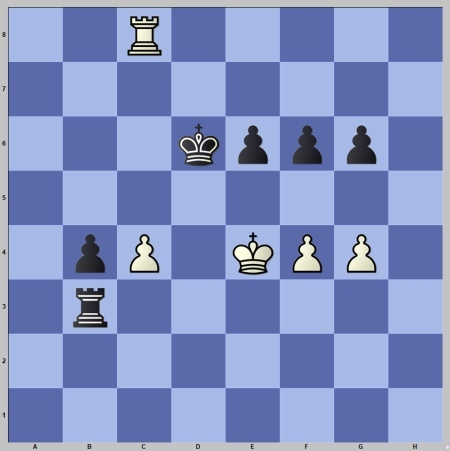
Black is slightly better, but White has to demonstrate accuracy. However, after 50.g5?? (50.c5+ was called for) Nana was simply winning. 50…fxg5 51.fxg5 Rc3 52. Kd4 e5+! 53. Ke4 b3 and Black’s b-pawn will cost White the rook.
This was the only victory for Dzagnidze in this tournament. She finished with 3,5 points. With this defeat, Vaishali ended the tournament in New Delhi in last place, with just two points. During this event, the young Indian player – who joined at the last minute as a replacement - showed great courage and talent. The tournament in New Delhi will be an important learning curve in her career.
Nino Batsiashvili – Zhu Jiner
Nino Batsiashvili had a tough tournament in Delhi, and it seems that only in the final rounds she found her element. On the other hand, Zhu Jiner was consistent throughout, not suffering a single defeat.
Nino and Zhu played three times, with two draws and one victory for Zhu. The Chinese player was a slight favourite in this match.
Following 1.d4 by Nino, Zhu opted for the flexible Nimzo-Indian Defence, which was a novelty in her repertoire at top events. After exchanges, the two converted into the Ragozin Defence.
This was the only victory for Dzagnidze in this tournament. She finished with 3,5 points. With this defeat, Vaishali ended the tournament in New Delhi in last place, with just two points. During this event, the young Indian player – who joined at the last minute as a replacement - showed great courage and talent. The tournament in New Delhi will be an important learning curve in her career.
Nino Batsiashvili – Zhu Jiner
Nino Batsiashvili had a tough tournament in Delhi, and it seems that only in the final rounds she found her element. On the other hand, Zhu Jiner was consistent throughout, not suffering a single defeat.
Nino and Zhu played three times, with two draws and one victory for Zhu. The Chinese player was a slight favourite in this match.
Following 1.d4 by Nino, Zhu opted for the flexible Nimzo-Indian Defence, which was a novelty in her repertoire at top events. After exchanges, the two converted into the Ragozin Defence.
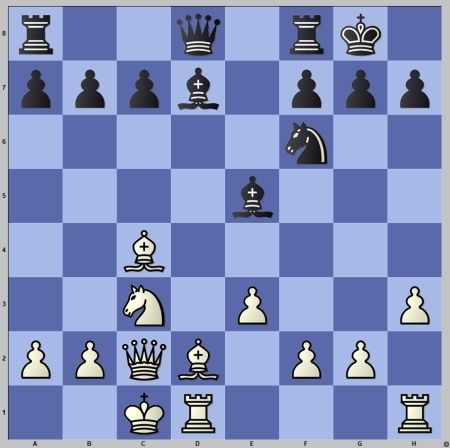
By castling long, Nino has just introduced a novelty. After 13…Qe7 14.Bd3 Bc6 she played 15.f4, planning to push the g- and h-pawns next. A provocative approach, giving up a pawn for the initiative.
Black accepted the sacrifice, but Zhu then decided to avoid sharp lines and returned the pawn to trade the queens, steering to an even position.
Black accepted the sacrifice, but Zhu then decided to avoid sharp lines and returned the pawn to trade the queens, steering to an even position.
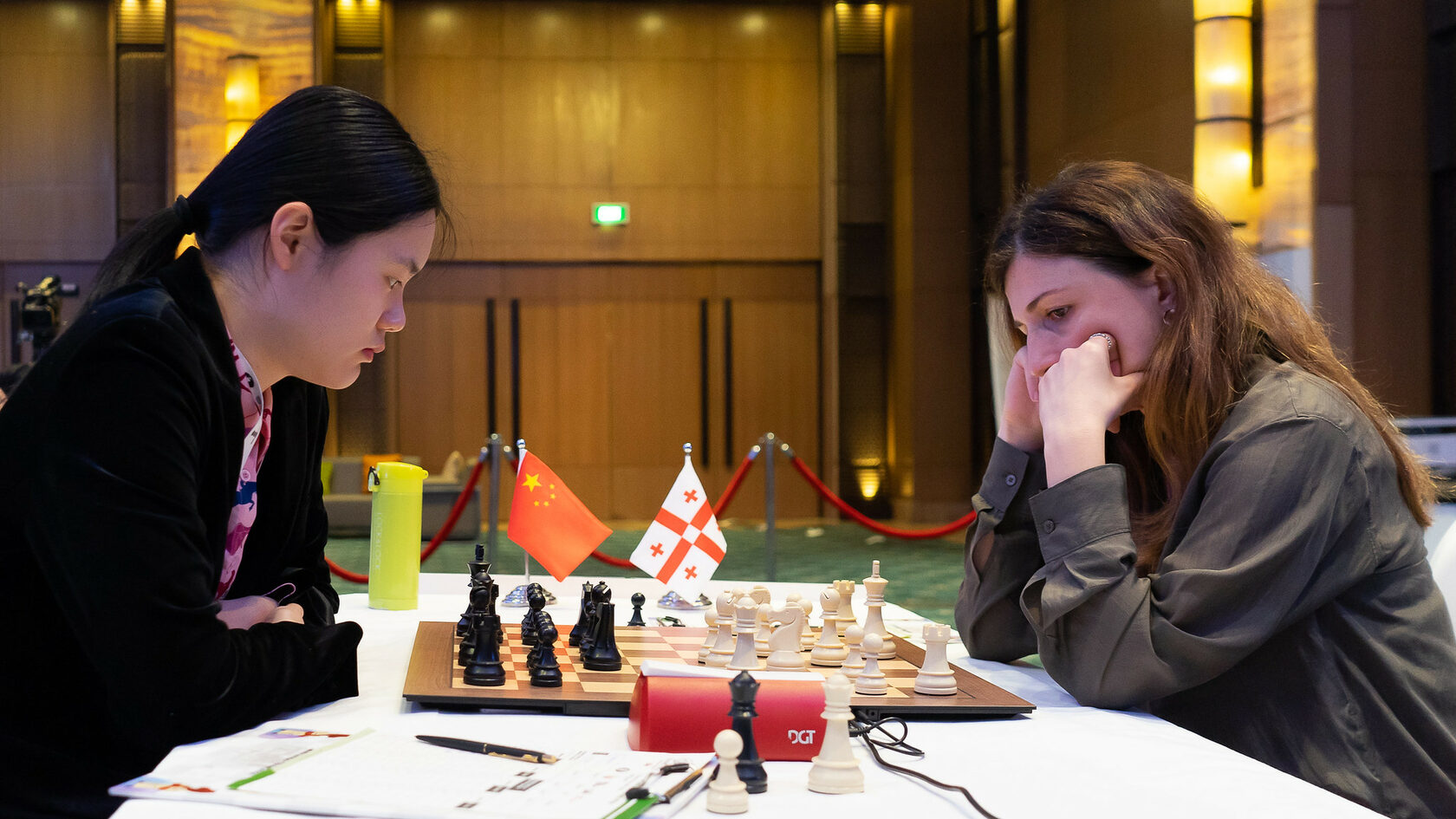
Batsiashvili tested Zhu a bit longer and even sacrificed an exchange, but it all came down to a drawish opposite-coloured bishop endgame in which the two called it a day.
Zhu finished the tournament with six points, having suffered no defeats.
Aleksandra Goryachkina – Humpy Koneru
This was a game between two experienced heavyweights in women’s chess. The two are currently tied for second place in the newest FIDE rating list. Both have played seven games so far, with each winning two, and three games ending in a draw.
Humpy went for the Queen’s gambit accepted in which Aleksandra opted for a line with an early queens exchange. White had a tiny edge throughout the game but it was not enough to turn it into something tangible.
Zhu finished the tournament with six points, having suffered no defeats.
Aleksandra Goryachkina – Humpy Koneru
This was a game between two experienced heavyweights in women’s chess. The two are currently tied for second place in the newest FIDE rating list. Both have played seven games so far, with each winning two, and three games ending in a draw.
Humpy went for the Queen’s gambit accepted in which Aleksandra opted for a line with an early queens exchange. White had a tiny edge throughout the game but it was not enough to turn it into something tangible.
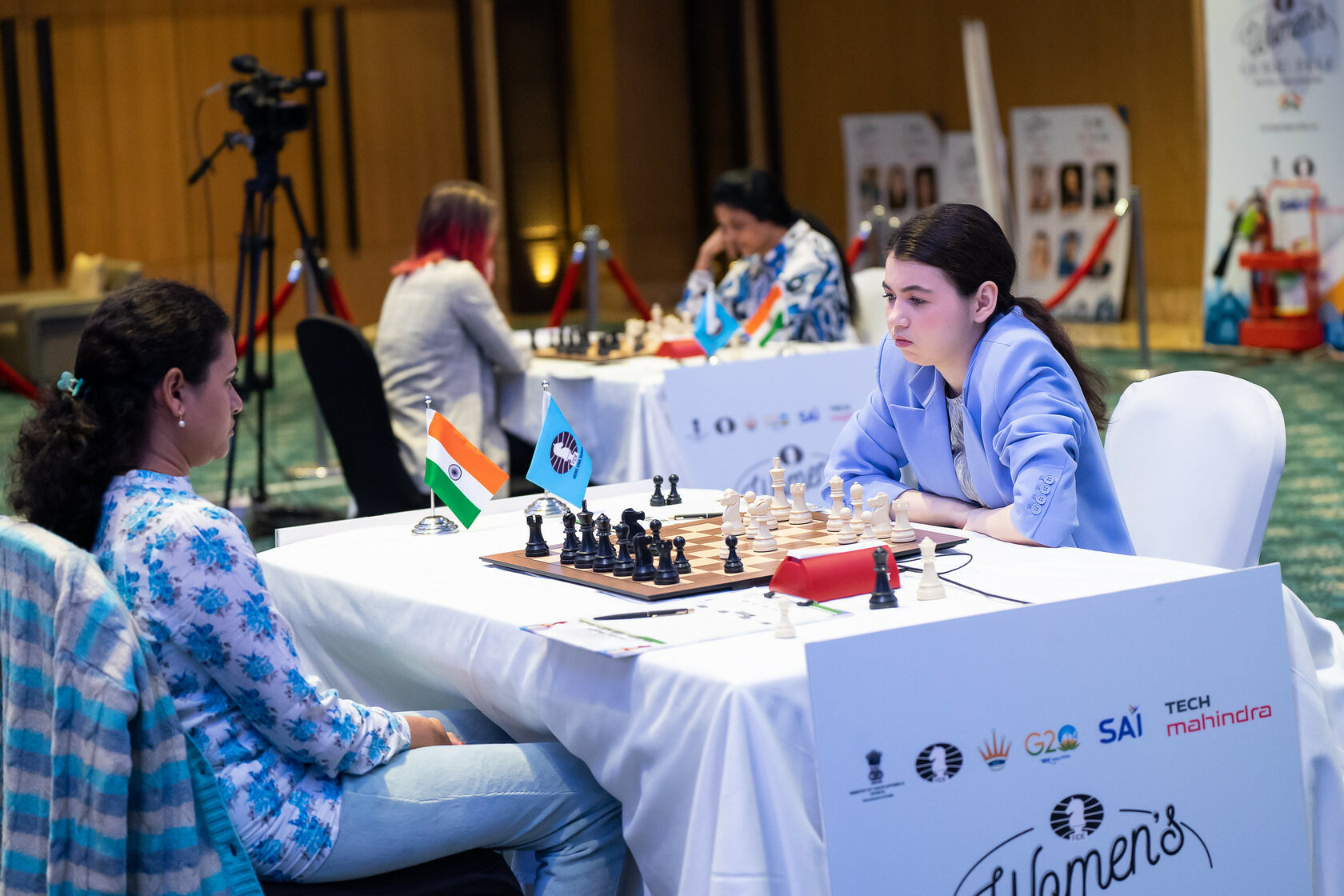
It was a pretty balanced game where both sides played within the limits of their positions and did not try to push hard. By move 29 they transitioned into a rook and bishop endgame. Black had a weak pawn on c6 but defended it well with a more active king and pieces. Goryachkina went for a threefold repetition.
A draw was enough for Goryachkina to end up in the shared first place, with two other players on six points.
Harika Dronavalli – Polina Shuvalova
Out of the six games the two have played so far, both Harika and Polina have an equal number of victories – three each.
This was only the third time in the tournament that Harika played as White, so she was looking to use her chances.
In the Anti-Marshall of Ruy Lopez Harika essayed 8.Bd2 line but did not achieve much.
A draw was enough for Goryachkina to end up in the shared first place, with two other players on six points.
Harika Dronavalli – Polina Shuvalova
Out of the six games the two have played so far, both Harika and Polina have an equal number of victories – three each.
This was only the third time in the tournament that Harika played as White, so she was looking to use her chances.
In the Anti-Marshall of Ruy Lopez Harika essayed 8.Bd2 line but did not achieve much.
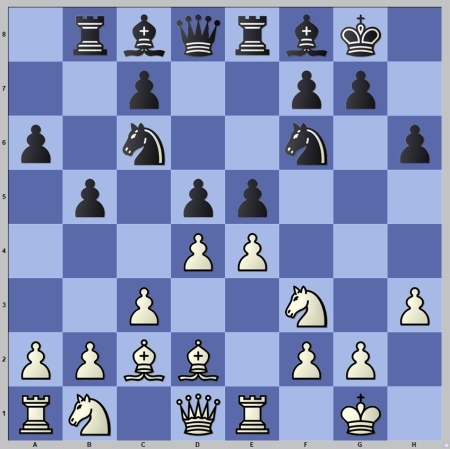
Here Black struck in the centre with 15…d5. Harika opted to take on e5 with her knight and ended up in an inferior position, while a better option was dxe5 with Bf4. Shuvalova had two bishops and a clear plan of pressuring the e5-pawn and activating rooks, which she started implementing.
Unfortunately for White, she did not demonstrate accuracy in defence and Black gradually took control of the game. Shuvalova won a pawn but was significantly worse on time at some point.
Dronavalli continued to err and soon allowed Black to advance on the kingside and put her rooks on White’s second rank. Although Polina’s conversion was not ideal, she eventually transposed into a bishop vs. knight endgame with two extra pawns.
Unfortunately for White, she did not demonstrate accuracy in defence and Black gradually took control of the game. Shuvalova won a pawn but was significantly worse on time at some point.
Dronavalli continued to err and soon allowed Black to advance on the kingside and put her rooks on White’s second rank. Although Polina’s conversion was not ideal, she eventually transposed into a bishop vs. knight endgame with two extra pawns.
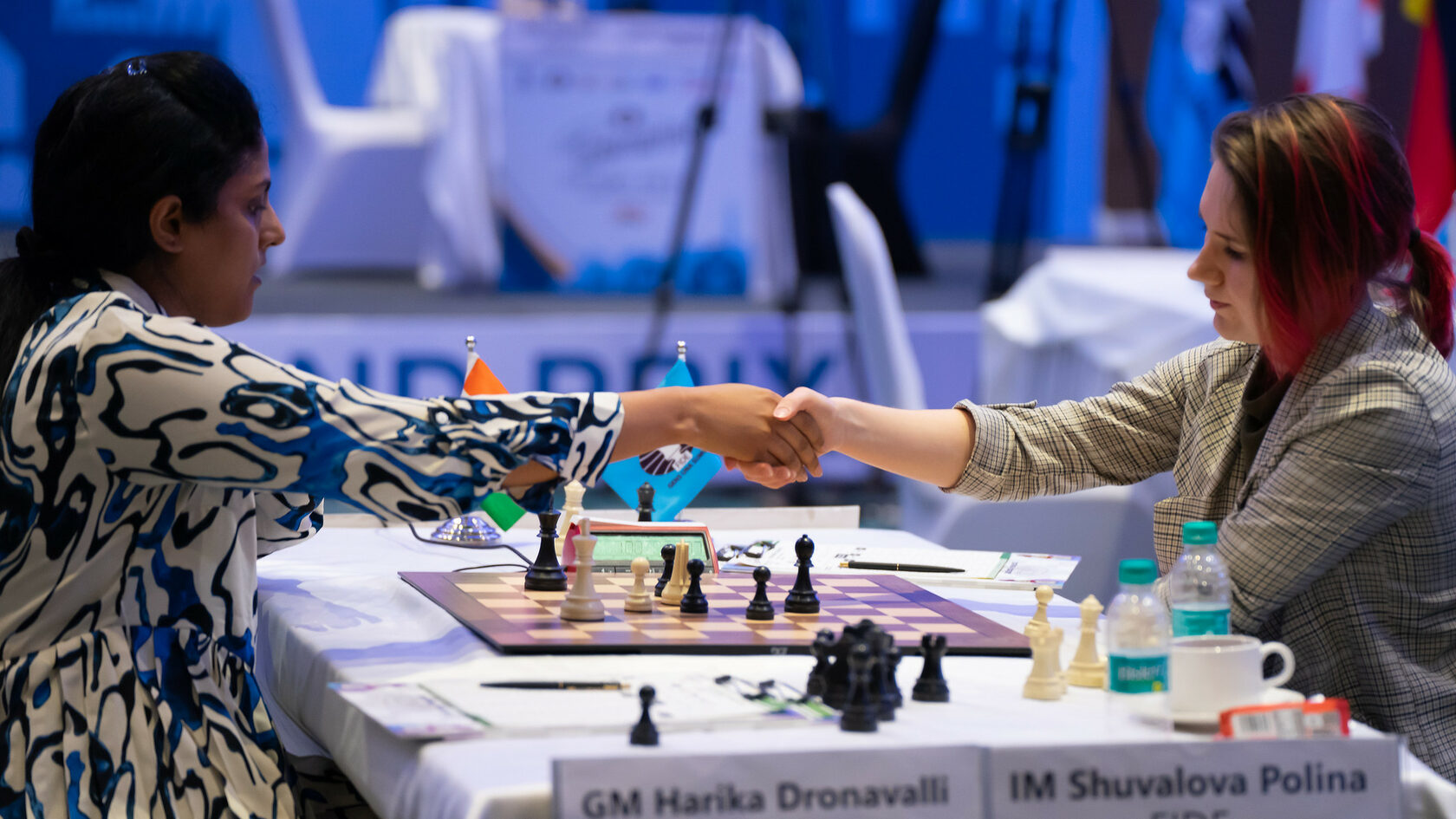
Just past six in the afternoon in New Delhi, Harika Dronavalli resigned. This was the last game of the Women’s Grand Prix in New Delhi.
“Chess is coming back to India”
The closing ceremony of the Women’s Grand Prix in New Delhi marked the end of a two-week event which made history in India.
The Women's Grand Prix in India wrapped up with a closing ceremony at the Leela Hotel in New Delhi. The event brought together chess players, fans, officials, and government representatives to celebrate what many are calling a milestone for Indian chess.
Dr. Sanjay Kapur, President of the All India Chess Federation, thanked the organizers and players for their hard work, noting that the tournament started with hiccups but ended on a high note. He went on to say that the return of chess to India is a significant development for the country and predicted that in five to six years, India will become the number one chess nation in the world. The audience erupted in applause.
“Chess coming back to India is a great thing for all Indians… This is a land of chess and chess coming back to its home. Many more players will come [from India]. Five-six years from today, we will be the number one chess nation in the world… We hope that chess will be played in every home in India, and that is our plan”, Dr Kapur said.
“Chess is coming back to India”
The closing ceremony of the Women’s Grand Prix in New Delhi marked the end of a two-week event which made history in India.
The Women's Grand Prix in India wrapped up with a closing ceremony at the Leela Hotel in New Delhi. The event brought together chess players, fans, officials, and government representatives to celebrate what many are calling a milestone for Indian chess.
Dr. Sanjay Kapur, President of the All India Chess Federation, thanked the organizers and players for their hard work, noting that the tournament started with hiccups but ended on a high note. He went on to say that the return of chess to India is a significant development for the country and predicted that in five to six years, India will become the number one chess nation in the world. The audience erupted in applause.
“Chess coming back to India is a great thing for all Indians… This is a land of chess and chess coming back to its home. Many more players will come [from India]. Five-six years from today, we will be the number one chess nation in the world… We hope that chess will be played in every home in India, and that is our plan”, Dr Kapur said.
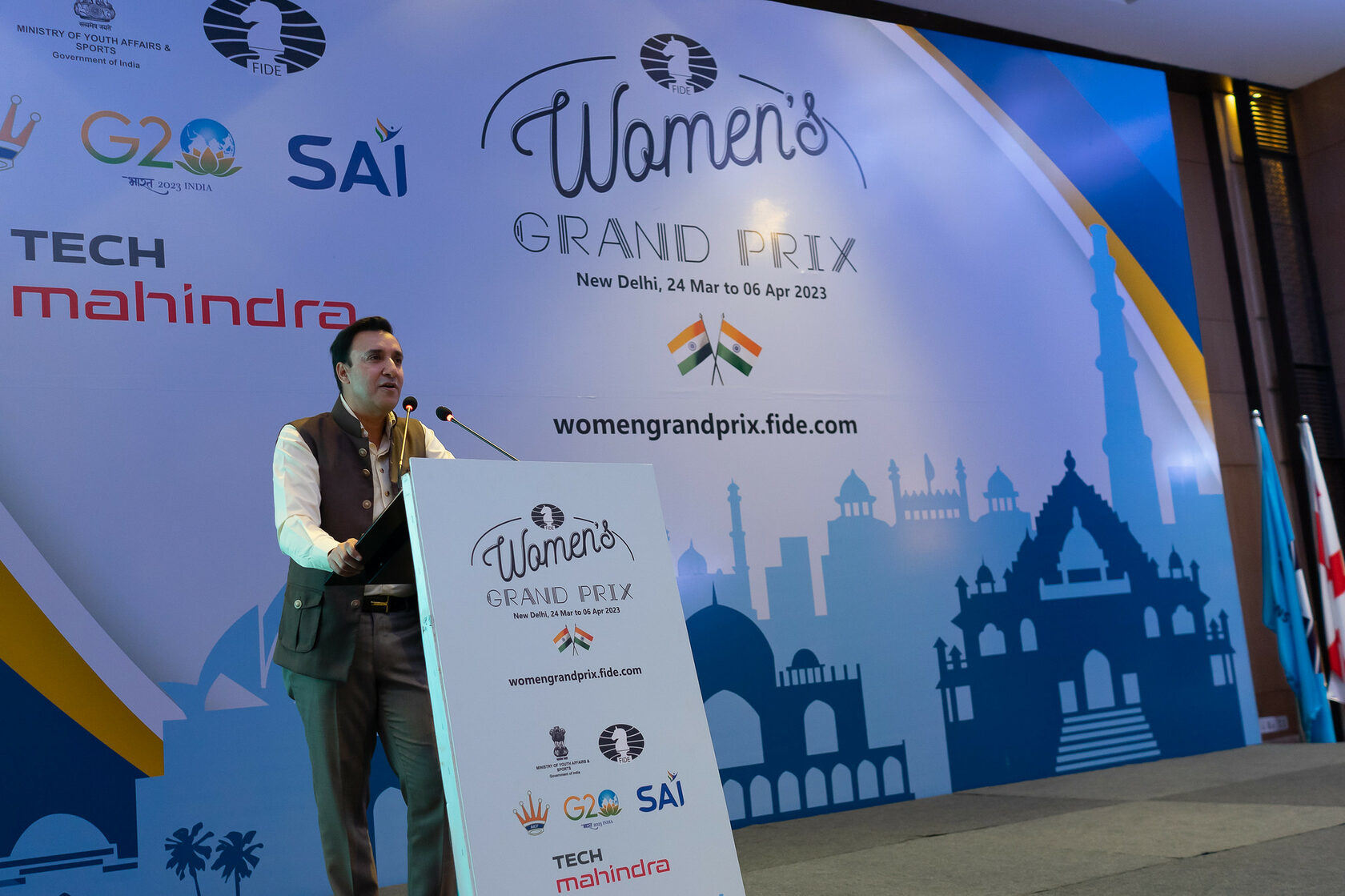
Jagadish Mitra, Senior Strategic Advisor at Tech Mahindra and the key sponsor of chess in India, also announced further support for the game.
"We have been committed to promoting chess in India for some time now, and we are delighted to continue doing that. In June, we will be sponsoring the Global Chess League (GCL), further demonstrating our dedication to this wonderful game not just in India but across the globe."
"We have been committed to promoting chess in India for some time now, and we are delighted to continue doing that. In June, we will be sponsoring the Global Chess League (GCL), further demonstrating our dedication to this wonderful game not just in India but across the globe."
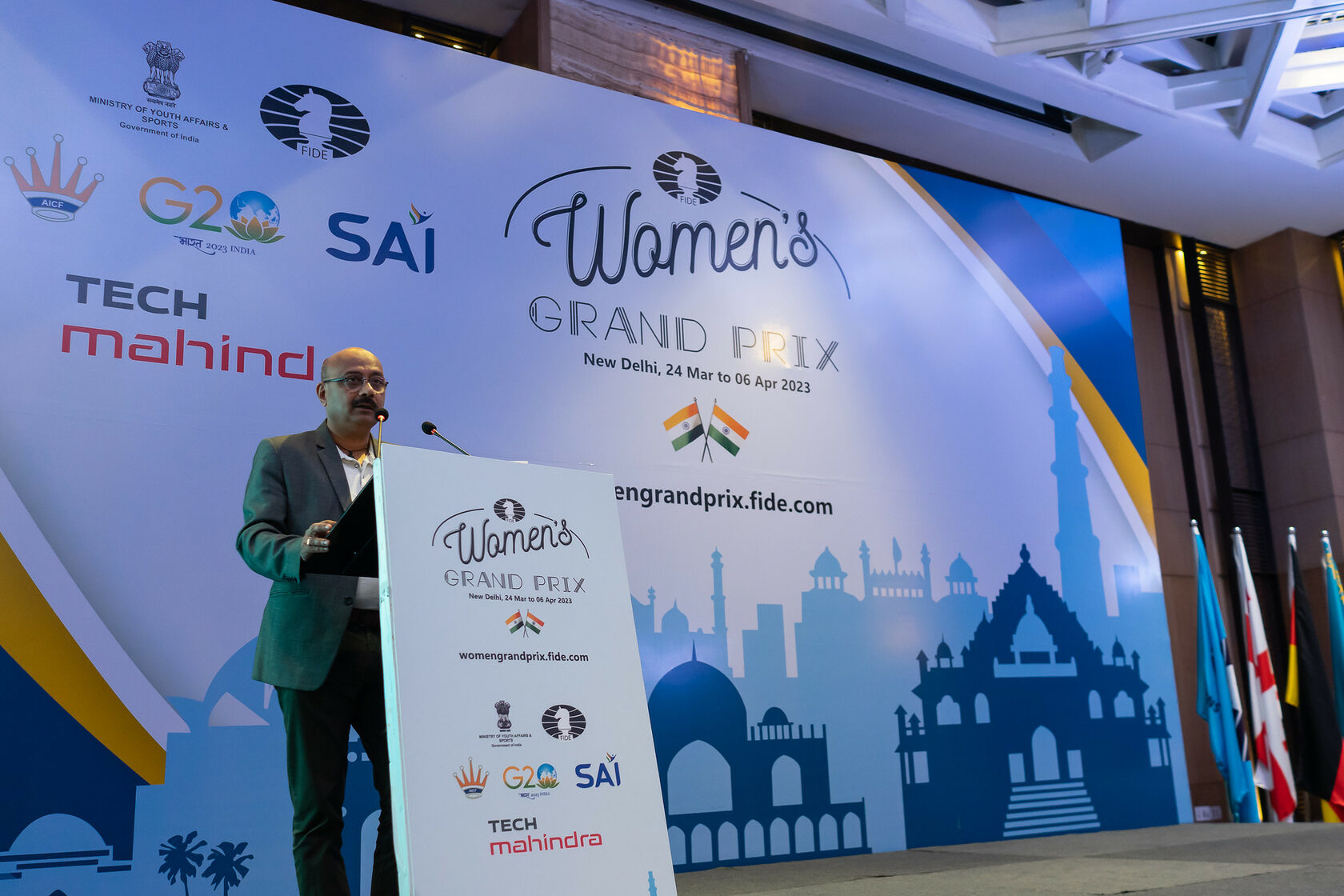
One of the highlights of the evening was the speech of Mrs Sonal Goel, a high-ranking official of the Indian Administrative Service. Goel praised the importance of chess in personal and social development, but her following sentence brought the most applause from the audience and signalled what place chess is set to have in Indian society.
“Chess belongs to India and we are all committed to ensuring that our young generation has an interest in chess as they do in cricket”, Goel said to which the audience erupted with huge applause.
Finally, all participants of the Women’s Grand Prix, including the top players in the event - Aleksandra Goryachkina, Bibisara Assaubayeva, and Ju Jiner - took to the stage to receive their awards. Wearing a vibrant red dress, Aleksandra Goryachkina beamed with joy as she was presented with a colossal trophy and medal by a group of esteemed Indian dignitaries.
“Chess belongs to India and we are all committed to ensuring that our young generation has an interest in chess as they do in cricket”, Goel said to which the audience erupted with huge applause.
Finally, all participants of the Women’s Grand Prix, including the top players in the event - Aleksandra Goryachkina, Bibisara Assaubayeva, and Ju Jiner - took to the stage to receive their awards. Wearing a vibrant red dress, Aleksandra Goryachkina beamed with joy as she was presented with a colossal trophy and medal by a group of esteemed Indian dignitaries.
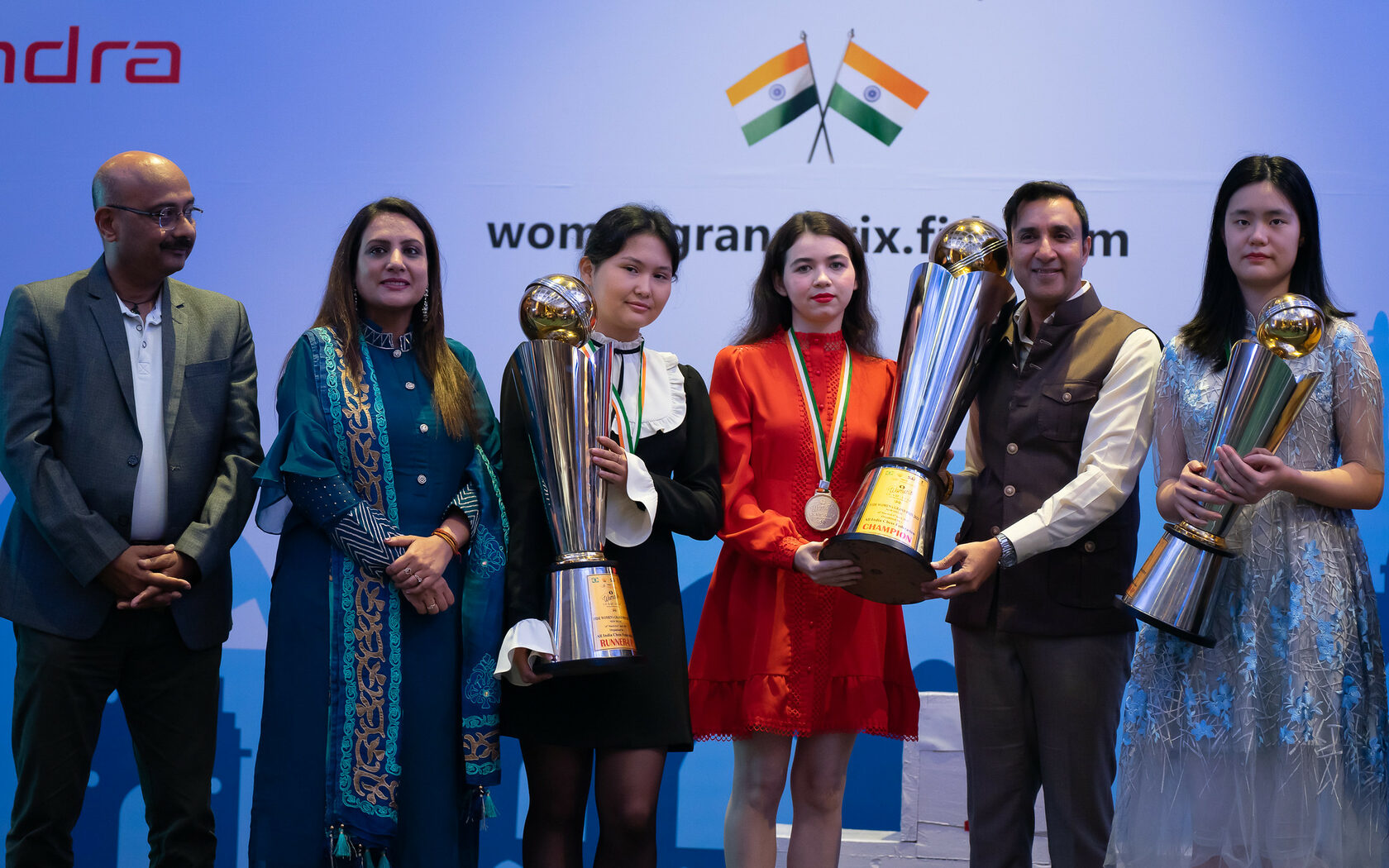
Following the Chess Olympiad held last year, the Women’s Grand Prix was the second huge chess event India has hosted. With the support of dedicated sponsors like Tech Mahindra and passionate organisers such as those in the All India Chess Federation, the game is set to thrive in India in the coming years.
Text: Milan Dinic
Photo: Ismael Nieto
About the Women’s Grand Prix
The FIDE Women’s Grand Prix consists of four tournaments played between September 2022 and May 2023 and includes 16 women players who take part in three of the four tournaments. The two players who score the greatest number of cumulative points in the series shall qualify for the FIDE Women Candidates Tournament 2023-24.
The players participating in the Women’s Grand Prix have been selected based on their performance in key FIDE events and their ELO. Also, each of the four local tournament organisers has a right to nominate a player of their choice.
The time control for the tournament is 90 minutes for the first 40 moves, followed by 30 minutes for the rest of the game with an increment of 30 seconds per move starting from move one.
The total prize fund for each one of the four events is €80,000, with another €80,000 being distributed among the top eight players in the overall standings for the Grand Prix series.
General information about the venue and the dates
The third leg of the Women’s Grand Prix will take place in New Delhi’s Leela Ambience Convention Hotel. The five-star hotel is designed to cater to business events and large meetings and should make an ideal place for a tournament of this level.
Text: Milan Dinic
Photo: Ismael Nieto
About the Women’s Grand Prix
The FIDE Women’s Grand Prix consists of four tournaments played between September 2022 and May 2023 and includes 16 women players who take part in three of the four tournaments. The two players who score the greatest number of cumulative points in the series shall qualify for the FIDE Women Candidates Tournament 2023-24.
The players participating in the Women’s Grand Prix have been selected based on their performance in key FIDE events and their ELO. Also, each of the four local tournament organisers has a right to nominate a player of their choice.
The time control for the tournament is 90 minutes for the first 40 moves, followed by 30 minutes for the rest of the game with an increment of 30 seconds per move starting from move one.
The total prize fund for each one of the four events is €80,000, with another €80,000 being distributed among the top eight players in the overall standings for the Grand Prix series.
General information about the venue and the dates
The third leg of the Women’s Grand Prix will take place in New Delhi’s Leela Ambience Convention Hotel. The five-star hotel is designed to cater to business events and large meetings and should make an ideal place for a tournament of this level.
